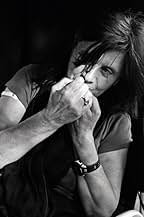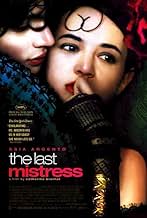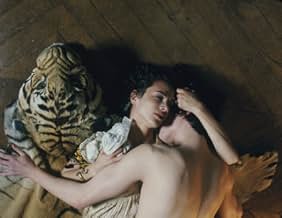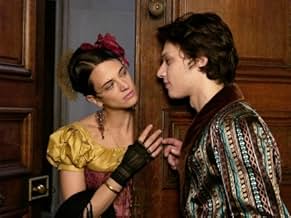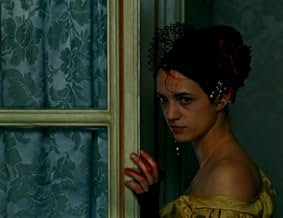Une vieille maîtresse
- 2007
- Tous publics
- 1h 49min
NOTE IMDb
6,2/10
3,9 k
MA NOTE
Ajouter une intrigue dans votre langueSecrets, rumors and betrayals surround the upcoming marriage between a young dissolute man and virtuous woman of the French aristocracy.Secrets, rumors and betrayals surround the upcoming marriage between a young dissolute man and virtuous woman of the French aristocracy.Secrets, rumors and betrayals surround the upcoming marriage between a young dissolute man and virtuous woman of the French aristocracy.
- Réalisation
- Scénario
- Casting principal
- Récompenses
- 3 nominations au total
Avis à la une
Although I've seen several of them now, I still don't know if I actually LIKE Catherine Breillat films. Her films are a strange contradiction: On one hand, they contain a lot of pretty graphic sex and always feature some of the most attractive actresses in Europe (and this one with Asia Argento and Roxanne Mesquia is certainly no exception). On the other though, they are often very depressing and told with such a harsh feminist bent that they probably make most people (well, most men anyway)feel more like castrating themselves than getting turned on. ( I actually haven't even seen her most notorious film, "Fat Girl", but after the truly depressing experience that was the supposedly very similar "36 Fillete" I've never wanted to).
You would expect then given Breillat's typical misanthropic bent that when she made a French costume drama like this one, the liaisons would be even more dangerous and the intentions even crueler. This is actually a surprisingly soft-hearted film though where all the main characters are pretty likable and sympathetic (at least in some ways). The only typically harsh Breillat touch is a couple having frenzied sex next to the funeral pyre of their dead daughter. The basic story involves a handsome young rake, who is about to marry a beautiful young heiress (Mesquia) with the blessing of her jaded-but-wise grandmother (who, since this is set in 1835, is herself a battle-scarred veteran of the original pre-revolutionary "dangerous liaison" era). He is unable to give up his long-time mistress, however, a social-climbing Spanish divorcée (Argento) with whom he has had a passionate ten year love-hate relationship. All the acting is very good and the characters believable (although you do have to wonder why a 19th Spanish noblewoman would have a tattoo on her butt). My only real complaint was that it was about a half an hour too long and the climax was pretty anti-climactic.
If you like either French costume dramas or typical Catherine Breillat films, you may or may not like this, since it ends being very different than either. It's not too bad though.
You would expect then given Breillat's typical misanthropic bent that when she made a French costume drama like this one, the liaisons would be even more dangerous and the intentions even crueler. This is actually a surprisingly soft-hearted film though where all the main characters are pretty likable and sympathetic (at least in some ways). The only typically harsh Breillat touch is a couple having frenzied sex next to the funeral pyre of their dead daughter. The basic story involves a handsome young rake, who is about to marry a beautiful young heiress (Mesquia) with the blessing of her jaded-but-wise grandmother (who, since this is set in 1835, is herself a battle-scarred veteran of the original pre-revolutionary "dangerous liaison" era). He is unable to give up his long-time mistress, however, a social-climbing Spanish divorcée (Argento) with whom he has had a passionate ten year love-hate relationship. All the acting is very good and the characters believable (although you do have to wonder why a 19th Spanish noblewoman would have a tattoo on her butt). My only real complaint was that it was about a half an hour too long and the climax was pretty anti-climactic.
If you like either French costume dramas or typical Catherine Breillat films, you may or may not like this, since it ends being very different than either. It's not too bad though.
For years,I pretty much avoided the "face of new Euro porn" films of French director Catherine Breillart (infamous for 'Romance',or 'Romance X',as it was known in Europe). When I heard she had taken on a film adaptation of the 19th century erotic masterpiece, 'The Last Mistress', I though to myself "grand...more boring Euro porn" (I walked out on 'Romance X' out of sheer boredom,and not of shock). Well, I was pleasantly surprised by 'Mistress'. Mind you, Breillart still has some growing up as a writer/director to do (there are things that transpire that are never explained),and her characters are still for the most part, unlikable. Apart from that, she has made some improvements. The cast includes Asia Argento,who doesn't seem to have any issues with tossing off her duds and parading around nude in any film she appears in,as well as several others,including veteran British actor Michael Lonsdale. The plot concerns a penniless,good for nothing young lad who is engaged to be married to a French woman of wealth & name, but has been an off again,on again lover of a half Spanish/half French woman of no certain valor. All I could think at times was 'Dangerous Liasions' meets 'Fatal Attraction',filtered thru a European perspective. This film obviously will not be everybody's cup of tea,but is still worth a look. No rating here,but probably only pull down a hard "R",due to nudity & some fairly restrained sexuality.
This is a beautiful period film with a lot of Breillat's trademark unflinching look at love and war between sexes. The story is old, but this is first time I see it put so frankly - they not marrying the the love of their life....
Sex is shot amazingly. There is an eyeful of historical detail and actors are looking great, dressed and undressed. The book it is based on according to Breillat, is autobiographical, which makes it even more interesting.
To put it simply - great work in many aspects.
Bravo again Catherine!
Sex is shot amazingly. There is an eyeful of historical detail and actors are looking great, dressed and undressed. The book it is based on according to Breillat, is autobiographical, which makes it even more interesting.
To put it simply - great work in many aspects.
Bravo again Catherine!
Milan Kundera writes: "Human time does not turn in a circle; it runs ahead in a straight line. That is why man cannot be happy: happiness is the longing for repetition." Case in point, Ryno de Marigny (Fu'ad Ait Aattou), an impoverished but elegantly handsome young man who is trapped between the aristocratic world to which he aspires, and an obsessive bond with a defiantly independent mistress, the boldly seductive Vellini (Asia Argento), an older but dazzling Spanish woman said to be born of an Italian noblewoman and a bullfighter. Adapted from a 19th-century novel Une vieille maîtresse by Jules-Amédée Barbey d'Aurevilly, Catherine Breillat's beautiful and elegant The Last Mistress, challenges the patriarchal assumptions of the age by depicting a 36-year old woman's right to fully express her sexual desires even if it is means flaunting society's conventions and Christian misogynist teachings.
Set in Paris in 1835, complete with elaborate period costumes and sumptuously decorated drawing rooms, the film opens with the gossip between two aging aristocrats, the Vicomte de Prony (Michael Lonsdale) and his wife, the Countess d'Artelles (Yolande Moreau about the ten-year affair between de Marigny and Vellini and the young man's impending marriage to the wealthy Hermangarde (Roxane Mesquida). Hermangarde's grandmother La marquise de Flers, excellently played by the 80-year-old French writer Claude Sarrate, is an open-minded and rational individual who claims to be a woman of the 18th century. Worried that Ryno will not be able to get over his passion for his fiery Spanish mistress, de Flers listens attentively as Ryno relates to her the details of his long relationship, an affair that he says has now come to an end, telling her that "You don't betray a new love with an old mistress".
In flashback, Ryno relates how he was overcome by Vellini's wild beauty after they were introduced at a party ten years before. Vellini, then married to a wealthy but dull Englishman, reacts negatively, however, when she overhears Ryno call her an ugly mutt and the young man is forced to vigorously pursue her despite her strong objections, forcing her to kiss him while the two are out riding. Her horrified husband witnesses the act and challenges Ryno to a duel the next morning. After deliberately missing his first shot, Ryno is shot in the chest, a wound from which he will take months to recover. The incident, however, triggers Vellini's awareness of her love for Ryno, exotically announced by her sucking the blood from the gaping hole in his chest.
De Flers presses Ryno for the details of their life together during the past ten years but the dramatic story is better left for the viewer to discover. When the film returns to present time, de Marigny and Hermangarde are married and ostensibly in love, yet he struggles to keep his word to her grandmother by moving away from the temptations of Paris to a remote seacoast. The cigar-smoking temptress, however, also loves the fresh sea air and the stage is set for the film's final act. The Last Mistress is an outstanding work of art that is strengthened immeasurably by striking performances by Asia Argento and first-time actor Fu'ad Ait Aattou. Argento fully captures Vellini's sexual assertiveness but tempers her incendiary disposition with naturalism and a tenderness that makes us care about her fate.
Aattou, discovered by Breillat in a crowded café, is almost feminine in appearance with overly thick lips and sensitive eyes, yet he brings a masculine determination to the role that makes him completely convincing. Like the recent film by Jacques Rivette, The Duchess of Langeais, in The Last Mistress love becomes a contest of wills, a power struggle between two people whose relationship consists of a tug of war not only between domination and submission but between 18th and 19th century social codes. That Breillat makes the ride so entrancing is a tribute to her enormous talent.
Set in Paris in 1835, complete with elaborate period costumes and sumptuously decorated drawing rooms, the film opens with the gossip between two aging aristocrats, the Vicomte de Prony (Michael Lonsdale) and his wife, the Countess d'Artelles (Yolande Moreau about the ten-year affair between de Marigny and Vellini and the young man's impending marriage to the wealthy Hermangarde (Roxane Mesquida). Hermangarde's grandmother La marquise de Flers, excellently played by the 80-year-old French writer Claude Sarrate, is an open-minded and rational individual who claims to be a woman of the 18th century. Worried that Ryno will not be able to get over his passion for his fiery Spanish mistress, de Flers listens attentively as Ryno relates to her the details of his long relationship, an affair that he says has now come to an end, telling her that "You don't betray a new love with an old mistress".
In flashback, Ryno relates how he was overcome by Vellini's wild beauty after they were introduced at a party ten years before. Vellini, then married to a wealthy but dull Englishman, reacts negatively, however, when she overhears Ryno call her an ugly mutt and the young man is forced to vigorously pursue her despite her strong objections, forcing her to kiss him while the two are out riding. Her horrified husband witnesses the act and challenges Ryno to a duel the next morning. After deliberately missing his first shot, Ryno is shot in the chest, a wound from which he will take months to recover. The incident, however, triggers Vellini's awareness of her love for Ryno, exotically announced by her sucking the blood from the gaping hole in his chest.
De Flers presses Ryno for the details of their life together during the past ten years but the dramatic story is better left for the viewer to discover. When the film returns to present time, de Marigny and Hermangarde are married and ostensibly in love, yet he struggles to keep his word to her grandmother by moving away from the temptations of Paris to a remote seacoast. The cigar-smoking temptress, however, also loves the fresh sea air and the stage is set for the film's final act. The Last Mistress is an outstanding work of art that is strengthened immeasurably by striking performances by Asia Argento and first-time actor Fu'ad Ait Aattou. Argento fully captures Vellini's sexual assertiveness but tempers her incendiary disposition with naturalism and a tenderness that makes us care about her fate.
Aattou, discovered by Breillat in a crowded café, is almost feminine in appearance with overly thick lips and sensitive eyes, yet he brings a masculine determination to the role that makes him completely convincing. Like the recent film by Jacques Rivette, The Duchess of Langeais, in The Last Mistress love becomes a contest of wills, a power struggle between two people whose relationship consists of a tug of war not only between domination and submission but between 18th and 19th century social codes. That Breillat makes the ride so entrancing is a tribute to her enormous talent.
Breillat's films are mostly small budget contemporary provocations with a feminist bent. This one, her twelfth, she says cost as much as ten previous ones and is a costume drama based on a controversial novel by Jules-Amédée Barbey d'Aurevilly (1808-1889). This is a bit confusing: the film begins by saying it's the century of Choderlos de Laclos (author of Dangerous Liaisons). but his famous work was written in 1782, and the action of d'Aurevilly's novel is set in 1835. The point is, the story is about the French aristocracy, and in the early nineteenth century its members still believed in and lived by the libertinism of Laclos.
In fact The Last Mistress (Une vieille maitresse) is a transitional story that links the two centuries and in a sense presents a romantic conception of the eighteenth century. Ryno de Marigny (beautiful newcomer Fu'ad Ait Aattou) is a high born young man who has squandered his wealth on his Spanish mistress, the willful Vellini (Asia Argento, in her element), with whom he's been involved for ten years. Allocine calls Ryno "a kind of romantic Valmont." But that's just it: there was nothing romantic about de Laclos' cruel and manipulative Valmont and Ryno is a new post-eighteenth-century conception of the eighteenth-century libertine that is titillated by his freedom but adds the emotional dressing of romantic passion. Breillat obviously loves this combination, is at home with it, and has given it deliriously appropriate treatment in this minor but beautiful, lush, and thoroughly enjoyable film.
The Breillat touch is perhaps most visible in the love-making scenes between Vellini and Ryno, in which there is much nudity and specificity of physical detail. Fu'ad Ait Aattou has pale skin and bigger lips than Asia Argento. By intention, both are androgynous; this is Breillat's conception of Choderlos de Laclos's and d'Aurevilly's libertines. The two actors are perfectly matched for this. Vellini is the aggressor; it is she who makes love with Ryno, using him like a lovely male statue made of alabaster. He is passionate like a romantic lover, however: that is, he's hung up on her forever, no matter what he tries. Early on, he fights a duel with her English husband and is wounded in the shoulder. The sex sequences are specific and fleshy as in no other costume drama, but Breillat is not creating an anachronistic work. As she explained in the NYFF press Q&A, she is passionate about the quality of her period detail and bought tons of lush materials and costumes. The dress, the jewelry, and the interiors are all completely authentic, and there is a rich color scheme in which red and green and yellow predominate. Without seeming over-glossy (it's not eye-candy like Sofia Coppola's Marie Antoinette), The Last Mistress is a pleasure to look at. It's also a pleasure to listen to, with its choice use of ornate and witty language. Oldtimer Michael Lonsdale as the gossipy Le vicomte de Prony particularly relishes his well-turned phrases.
As the story gets under way, Ryno has now found a wife, the beautiful young blonde noblewoman Hermangarde (Breillat regular Roxane Mesquida), and he's in love with her, and tired of Villini. Hermangarde's grandmother, the Marquise de Flers (non-actress Claude Sarraute, daughter of novelist Nathalie) is responsible for vetting Ryno, and in a lengthy sequence that's the heart of the film, he confesses to her everything about his relationship with Vellini. After much has been told (and shown on screen) in an amusing moment we see the Marquise reclining low in her seat: she is exhausted, but entranced. She wants to hear every detail. The Marquise is of course, of the older generation--a real Choderlos de Laclos lady. For her, the information that Ryno is a true libertine is proof that he is reliable, not an unknown quantity. And the cards are on the table. He'll do.
Rybno has every intention of having done with Vellini, and in a scene we've observed before his confession, he's made love with her one last time and they've said their adieus and adioses. Afrter his marriage, which we don't see, Ryno and Hermangarde live in a castle by the sea--so that he can avoid the temptations of Paris. Velllini waits four months, and then she appears. And once she is in front of Ryno, despite his professions of being fed up with her, he can't resist her.
There are several scenes in which Vellini draws blood from Ryno and licks it up: hints or Ms. Argento's father's films? Part of the New York Film Festival 2007. Three years after a stroke, Breillat is clearly in fine form--never better--and this is a long-awaited (by her) labor of love.
In fact The Last Mistress (Une vieille maitresse) is a transitional story that links the two centuries and in a sense presents a romantic conception of the eighteenth century. Ryno de Marigny (beautiful newcomer Fu'ad Ait Aattou) is a high born young man who has squandered his wealth on his Spanish mistress, the willful Vellini (Asia Argento, in her element), with whom he's been involved for ten years. Allocine calls Ryno "a kind of romantic Valmont." But that's just it: there was nothing romantic about de Laclos' cruel and manipulative Valmont and Ryno is a new post-eighteenth-century conception of the eighteenth-century libertine that is titillated by his freedom but adds the emotional dressing of romantic passion. Breillat obviously loves this combination, is at home with it, and has given it deliriously appropriate treatment in this minor but beautiful, lush, and thoroughly enjoyable film.
The Breillat touch is perhaps most visible in the love-making scenes between Vellini and Ryno, in which there is much nudity and specificity of physical detail. Fu'ad Ait Aattou has pale skin and bigger lips than Asia Argento. By intention, both are androgynous; this is Breillat's conception of Choderlos de Laclos's and d'Aurevilly's libertines. The two actors are perfectly matched for this. Vellini is the aggressor; it is she who makes love with Ryno, using him like a lovely male statue made of alabaster. He is passionate like a romantic lover, however: that is, he's hung up on her forever, no matter what he tries. Early on, he fights a duel with her English husband and is wounded in the shoulder. The sex sequences are specific and fleshy as in no other costume drama, but Breillat is not creating an anachronistic work. As she explained in the NYFF press Q&A, she is passionate about the quality of her period detail and bought tons of lush materials and costumes. The dress, the jewelry, and the interiors are all completely authentic, and there is a rich color scheme in which red and green and yellow predominate. Without seeming over-glossy (it's not eye-candy like Sofia Coppola's Marie Antoinette), The Last Mistress is a pleasure to look at. It's also a pleasure to listen to, with its choice use of ornate and witty language. Oldtimer Michael Lonsdale as the gossipy Le vicomte de Prony particularly relishes his well-turned phrases.
As the story gets under way, Ryno has now found a wife, the beautiful young blonde noblewoman Hermangarde (Breillat regular Roxane Mesquida), and he's in love with her, and tired of Villini. Hermangarde's grandmother, the Marquise de Flers (non-actress Claude Sarraute, daughter of novelist Nathalie) is responsible for vetting Ryno, and in a lengthy sequence that's the heart of the film, he confesses to her everything about his relationship with Vellini. After much has been told (and shown on screen) in an amusing moment we see the Marquise reclining low in her seat: she is exhausted, but entranced. She wants to hear every detail. The Marquise is of course, of the older generation--a real Choderlos de Laclos lady. For her, the information that Ryno is a true libertine is proof that he is reliable, not an unknown quantity. And the cards are on the table. He'll do.
Rybno has every intention of having done with Vellini, and in a scene we've observed before his confession, he's made love with her one last time and they've said their adieus and adioses. Afrter his marriage, which we don't see, Ryno and Hermangarde live in a castle by the sea--so that he can avoid the temptations of Paris. Velllini waits four months, and then she appears. And once she is in front of Ryno, despite his professions of being fed up with her, he can't resist her.
There are several scenes in which Vellini draws blood from Ryno and licks it up: hints or Ms. Argento's father's films? Part of the New York Film Festival 2007. Three years after a stroke, Breillat is clearly in fine form--never better--and this is a long-awaited (by her) labor of love.
Le saviez-vous
- AnecdotesCatherine Breillat discovered Fu'ad Aït Aattou in a Paris café.
- GaffesWhile Ryno is descending the stairs at the opera, an Edgar Degas mural can be seen. Degas would have only just been born in this era.
- ConnexionsFeatured in Metropolis: Cannes 2007 - Special (2007)
Meilleurs choix
Connectez-vous pour évaluer et suivre la liste de favoris afin de recevoir des recommandations personnalisées
- How long is The Last Mistress?Alimenté par Alexa
Détails
- Date de sortie
- Pays d’origine
- Langues
- Aussi connu sous le nom de
- The Last Mistress
- Lieux de tournage
- Île de Bréhat, Côtes-d'Armor, France(Moulin du Birlot: Vellini's house in Brittany)
- Sociétés de production
- Voir plus de crédits d'entreprise sur IMDbPro
Box-office
- Budget
- 6 000 000 $US (estimé)
- Montant brut aux États-Unis et au Canada
- 785 671 $US
- Week-end de sortie aux États-Unis et au Canada
- 33 554 $US
- 29 juin 2008
- Montant brut mondial
- 1 831 577 $US
- Durée1 heure 49 minutes
- Couleur
- Mixage
- Rapport de forme
- 1.85 : 1
Contribuer à cette page
Suggérer une modification ou ajouter du contenu manquant



